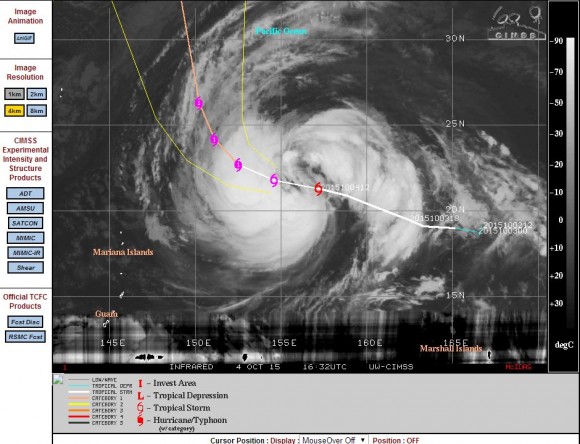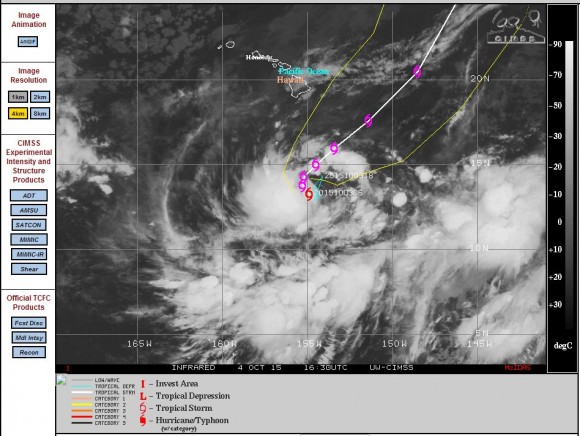Due to such warm waters lying across the equatorial regions of the Pacific Ocean, a number of active storms continue to form then move pole wards before weakening at higher latitudes.
The Pacific Ocean has certainly been a production zone for tropical storm events, many of which do not make landfall. In addition to Typhoon Mujigae which has now made landfall, there are two other other storm systems of interest as well as other low pressure systems that have potential for development. The following storms are unlikely to make landfall but shows how many storm events there at the present time.
1 - Tropical Storm Oho
This storm is south east of the Big Island of Hawaii but given its environment, it will struggle to transition into a fully fledged hurricane. However, it is still reasonably strong with wind speeds of 55 knots at the centre (Approximately 102 km/h). The storm will approach the threshold of a hurricane off Hawaii but will struggle due to shear that will eventually tear the storm apart as it tracks north east. There have been flights into the storm to verify its strength and further flights are planned in the near future.
There is a second area of tropical disturbance south west of Hawaii that is receiving attention but it is not clear if that storm will develop further or not.
2 - Tropical Storm Choi Wan
A tropical storm continues to develop some 800 nautical miles north east of Guam over open ocean. The storm is already sustaining peak winds of 55 knots (Approximately 102 km/h) and is on the threshold of of transitioning into the next typhoon over the north west Pacific Ocean. The storm is expected to sustain winds of 80 knots (Approximately 148 km/h with wind gusts of 100 knots (185 km/h) over the forecast period and hence a Category 1 typhoon. A stronger typhoon cannot be ruled out. At least this storm is unlikely to make landfall given its position and expected forecast track.
3 - Tropical storm Marty
This storm formed and decayed off the west coast of Mexico over recent days. The storm just reached the threshold of a Category 1 hurricane although it was brief. The storm decayed as it approached the coast and broke apart. Generally, it spent its entire life over open ocean.
There are 3 active storms across the Pacific Ocean with another under watch and one over the North Atlantic Ocean at the present time. One of those Pacific Ocean storms has made landfall (Typhoon Mujigae) and hence that storm will now break apart.
What is interesting, is that the Pacific Ocean has been by far the most active ocean, followed by the northern Atlantic Ocean. However very few storms have formed across the Indian Ocean over recent months. With the change in season under way and the southern hemisphere now moving towards the summer months, it would be expected that the number of storm events across the northern hemisphere oceans decrease while an increase in number occur across the southern hemisphere oceans especially near to Australian Waters. To date, the Indian Ocean is relatively quiet with no storms of interest forming. Further, there are no storms of interest across the southern tropical Pacific Ocean waters. However given time, that is expected to change.
CREDITS
CIMSS (Storms plots for Oho and Choi Wan) acquired 5/10/2015.


